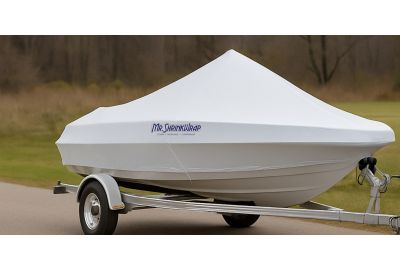What Size Shrink Wrap Do You Really Need for Your Boat?
Every fall, as the air turns crisp and the days grow shorter, boat owners face the same big question: how can I keep my boat safe through the winter? Shrink wrapping is one of the best ways to protect your boat from snow, ice, and all the unpredictable weather winter brings. But here’s where many people get stuck—choosing the right size shrink wrap. Get it wrong, and you’ll either come up short (frustrating!) or waste money on material you don’t need.
Since 1991, we’ve wrapped everything from small fishing boats to 50-foot cruisers (and even some things that definitely aren’t boats). Here’s the simple way to figure out what size shrink wrap your boat really needs.
Why the Right Size Matters
Shrink wrap isn’t just a cover; it’s a durable, weatherproof barrier. If the material is too small, you won’t get complete coverage. If it’s too large, you’ll waste plastic and end up with sloppy seams. Choosing the right size ensures:
-
Better protection against snow, rain, and ice buildup
-
Less risk of tearing in strong winds
-
Easier installation with less waste
Think of it like buying a winter coat: you don’t want it so tight it won’t zip, and you don’t want it so loose that it lets the cold air in.
Two Ways to Figure Out Shrink Wrap Size
There are two methods we use in the field. One is quick and easy, the other is more exact use whichever makes the most sense for your boat.
Method 1: The Quick Tape Measure Trick
This one’s simple and works best for smaller boats:
-
Measure side to side – from the perimeter strap on one side, over the tallest point of the boat, to the strap on the other side.
-
Measure front to back – from the motor (or stern) to the bow.
-
Add about a foot on each side to give yourself room to tuck and weld.
Done. That’ll give you a good ballpark for the shrink wrap size.
Method 2: The Shrink Wrap Formula
If you want to be more precise—or you’ve got a bigger boat—this is the method we recommend:
-
Above the Rub Rail: Measure from the rub rail up to the tallest point of the boat.
-
Below the Rub Rail: Decide how far down you want the wrap to go (we suggest down to the waterline).
-
Tucking & Fusing: Add 6–12 inches on each side for folding and heat-welding.
Add those three numbers together, then multiply by 2. That’s your shrink wrap width.
Which Thickness Should You Choose?
Not all shrink wrap is created equal. Here’s a quick breakdown:
-
6 Mil Shrink Wrap – Strong enough for smaller boats and short-term storage. Lightweight and easy to handle.
-
7 Mil Shrink Wrap – The go-to choice for most boat owners. Durable, reliable, and built to handle long winters outdoors.
When in doubt, choose 7 mil. It’s the standard used by most professionals for recreational boats.
A Few Pro Tips from the Field
-
Measure at the longest and tallest points: don’t rely on guesswork.
-
Leave enough room for tucking and fusing: a little extra now prevents big headaches later.
-
Use the right tools: a reliable heat gun, strong perimeter strapping, vents, and high-quality shrink wrap tape.
-
If you’re new to wrapping, check out our step-by-step how-to videos on YouTube and Facebook before you get started.
Why Boat Owners Trust Mr. Shrinkwrap
We started back in 1991 as a small boat wrapping service, and today we supply shrink wrap and accessories worldwide. Over the years, we’ve wrapped everything you can imagine—boats, patio furniture, machinery, even turbines. That experience is what sets us apart.
When you buy from Mr. Shrinkwrap, you’re not just getting plastic film. You’re getting products that we’ve tested in the field, and advice from a team that’s been doing this for over 30 years.


